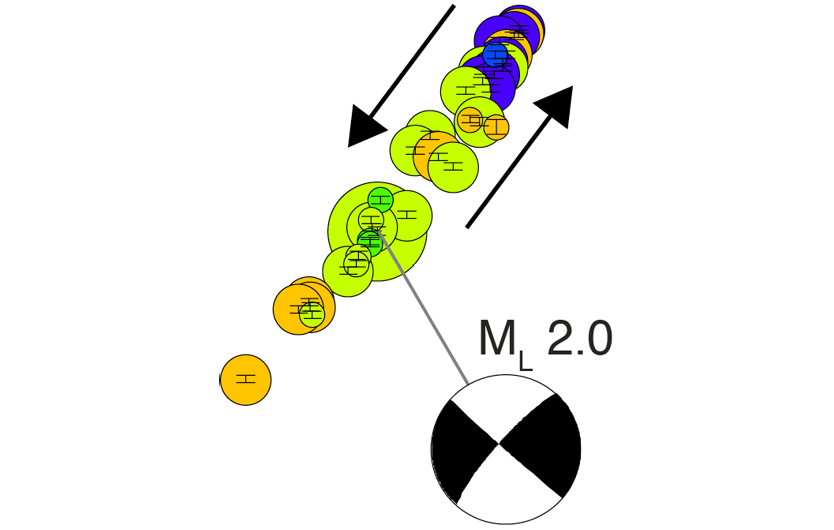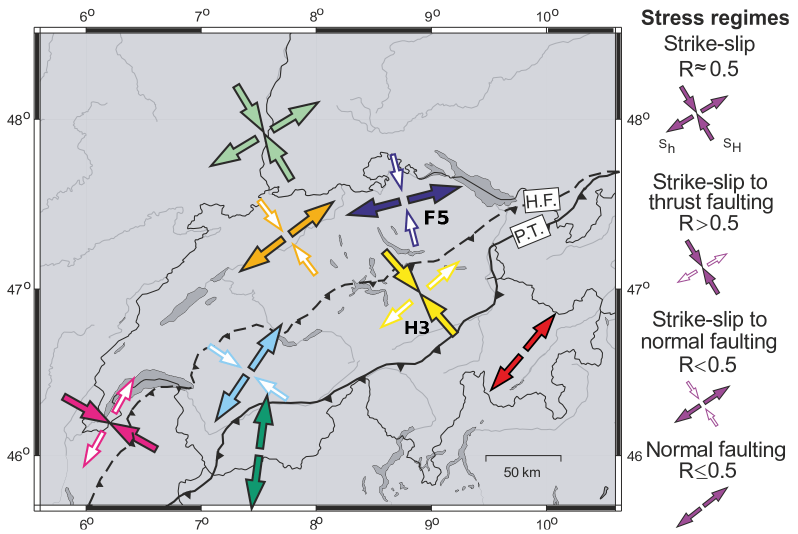Seismotectonics
Seismotectonics studies the relationship between earthquakes, faults, and tectonic processes. It incorporates information from various disciplines including seismology, geodesy, and geology. The analysis of seismological data provides information on the geometry and the sense of motion of earthquake ruptures. The joint interpretation of many earthquakes allows conclusions on the tectonic stress regime, which is, in combination with information on fault orientations, fundamental for providing estimates on the seismic hazard of a region.
Illustration: Depth profile of high-precision hypocenter locations of an earthquake sequence close to Winterthur in April 2014. The focal mechanism (beach-ball symbol) of the ML 2.0 event of April 17th indicates a westward dipping normal fault in the crystalline basement.

What is Seismotectonics?
The seismotectonics group at the Swiss Seismological Service (SED) studies the relationship between earthquakes, individual faults, and tectonic processes in Switzerland and other tectonically active regions in the world. Seismotectonics mainly incorporate information from precise earthquake locations, focal mechanisms, structure and properties of the lithosphere imaged by passive and active seismic data, geodesy, and geology. The primary goal of seismotectonics analysis at the SED is the determination of focal mechanisms of earthquakes from seismic records (seismograms). The focal mechanism provides information on the geometry and the sense of motion of the rupture associated with individual earthquakes. The unambiguous identification of the active rupture plane, however, requires the joint interpretation of the focal mechanism and high-precision hypocenter locations of fore- and aftershocks of the earthquake. In some cases, the identified rupture plane can also be associated with faults known from geological or seismic reflection surveys.
What can we learn from Seismotectonics?
Identified rupture planes in combination with the associated sense of motion allow conclusions on the tectonic regime of a region. Although the mechanisms of single earthquakes contain mainly information on the deformation and are often biased by preexisting structures, the joint interpretation of many earthquakes is representative of the tectonic stress regime of a region. In Switzerland, various different tectonic stress regimes have been identified in the past years, which are mainly driven by large-scale plate tectonic processes such as the collision between the European and African plate and dynamic processes in the Earth’s mantle beneath the Alps. While large parts of the northern Alpine foreland of Switzerland and the northern parts of the Swiss Alps are dominated by compression oriented more or less perpendicular to the strike of the Alps, extension is the dominating tectonic regime in the regions south of the Rhône Valley in the Valais and in parts of Graubünden.
Finally, the provided information on the stress regime in combination with identified faults and fault orientations is fundamental for estimating the seismic hazard.
Map showing horizontal tectonic stress components in Switzerland derived from the analysis of earthquake mechanisms [Kastrup et al. 2004, Journal Geophysical Research; Marschall et al. 2013, Swiss Journal of Geoscience]
